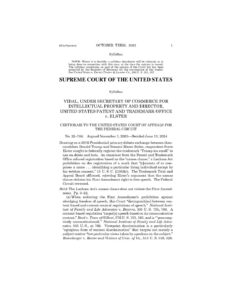By Anisha Kingra
On June 13, 2024, the Supreme Court issued a unanimous opinion announcing that the Lanham Act’s names clause does not violate the First Amendment. Justices Barrett and Sotomayor issued separately-authored concurring opinions debating the majority’s use of history to assess the constitutionality of the statute.
The Majority Opinion
Section 1052(c) of the Lanham Act directs the USPTO to refuse registration of a mark that “[c]onsists of or comprises a name, portrait, or signature identifying a particular living individual except by his written consent.” In 2018, Steve Elster filed an application with the USPTO seeking to register the mark “TRUMP TOO SMALL” on shirts. Elster did not obtain President Trump’s consent to use his name. For that reason, the Examining Attorney refused registration. Elster contended that the names clause restriction violated his First Amendment right to free speech. The Trademark Trial and Appeal Board affirmed. The Federal Circuit reversed, holding that the names clause violated the First Amendment.
The Supreme Court held that the names clause does not violate the First Amendment’s right to free speech. In reaching this conclusion, the Court announced that the names clause is a viewpoint-neutral but content-based trademark regulation. The sole inquiry involved in assessing a proposed mark under the names clause is whether the mark includes a living person’s name. That inquiry does not require an assessment of a particular viewpoint but it does require an assessment of the contents of the application. Specifically, whether the application contains a living person’s name.
Next, the Court considered – for the first time – the constitutionality of a content-based but viewpoint-neutral trademark restriction. The Court traced common law trademark rights, nineteenth century cases involving trademarks, and the enactment of the Lanham Act in 1946. This history, the Court explained, “demonstrates that restrictions on trademarks have always turned on a mark’s content.” Yet, the content-based nature of trademark law has always coexisted with First Amendment rights. And “[t]hat longstanding, harmonious relationship suggests that heightened scrutiny need not always apply in this unique context.” 602 U.S. ___ (2024).
The Court then turned to American history and tradition to inform its conclusion that the names clause did not violate the First Amendment. The United States has deeply-rooted traditions in restricting the trademarking of names. This was grounded in the notion that individuals have ownership over their names. Common law principles prevented individuals from trademarking their names because every person had the right to use their own name for purposes of trade. Furthermore, the restriction on trademarking names protected the mark owner’s reputation. For those reasons, “a party has no First Amendment right to piggyback off the goodwill another entity has built in its name.” 602 U.S. ___ (2024).
The Court unanimously agreed that the names clause is a viewpoint-neutral, content-based trademark restriction. The Court was also unanimous in its opinion that strict scrutiny was not an appropriate framework for assessing the constitutionality of trademark regulations. The justices were splintered as to the methodology used to assess the constitutionality of a trademark restriction. Under the competing approaches, though, the justices issuing concurring opinions still believed the names clause passed constitutional muster.
The Concurring Opinions
In a one-paragraph opinion, Justice Kavanaugh stated that a viewpoint-neutral, content-based trademark restriction may be constitutional absent a rich historical record, and set forth his willingness to address that issue in an appropriate future case.
Justice Barrett issued a concurring opinion, disagreeing with the Court’s use of history and tradition to assess the constitutionality of the names clause. In that opinion, Justice Barrett contended that the majority’s evidence consisted of “loosely related” nineteenth and twentieth century cases that did not establish a historical analogue to the names clause. Moreover, the majority failed to explain why the historical approach was the correct way to analyze the constitutional question. Justice Barrett proposed a functional assessment that permits restrictions that are reasonable as long as they support the trademark system’s purpose of facilitating source identification.
Justice Barret proposed that judicial review of trademark restrictions should consider whether the restriction reasonably related to preserving the mark owner’s goodwill and preventing consumer confusion. If so, the restriction helps ensure the registered mark functions as a source identifier and does not violate the First Amendment. Under this assessment, Justice Barrett believed the names clause to be constitutional as the clause protects producer goodwill by barring others from capitalizing on the reputation of the names of others. And, if the mark owner’s goods and services have poor quality, the mark owner might jeopardize the named individual’s reputation. Consent to trademark a living person’s name thus did not violate the right to free speech.
Justice Sotomayor issued a concurring opinion, agreeing with the judgment but contesting the majority’s historical assessment. Specifically, Justice Sotomayor noted that the history-focused approach implemented to analyze constitutional questions had generated confusion in lower court decisions and spoke of a reluctance to “go further down this precipice of looking for questionable historical analogues to resolve the constitutionality of Congress’s legislation.” Justice Sotomayor proposed assessing whether the denial of a trademark registration turns on reasonable, viewpoint-neutral content regulations. If so, the restriction is constitutional under the First Amendment. Justice Sotomayor proposed the following assessment: first, ask whether the restriction is viewpoint-based. If so, the restriction is presumptively unconstitutional and strict scrutiny applies. If the restriction is viewpoint-neutral, the trademark registration bar need only be reasonable in light of the purpose of the trademark system. Namely, the restriction must reasonably serve its purpose of identifying and distinguishing goods for the public.
The Court’s holding indicates that applicants must still obtain consent to register a mark using a living person’s name. Globally, the opinion suggested that the debate remains ongoing about whether the history-and-tradition framework set forth in New York States Rifle Assn., Inc. v. Bruen, 597 U.S. 1 (2022) is workable when assessing constitutional issues.

